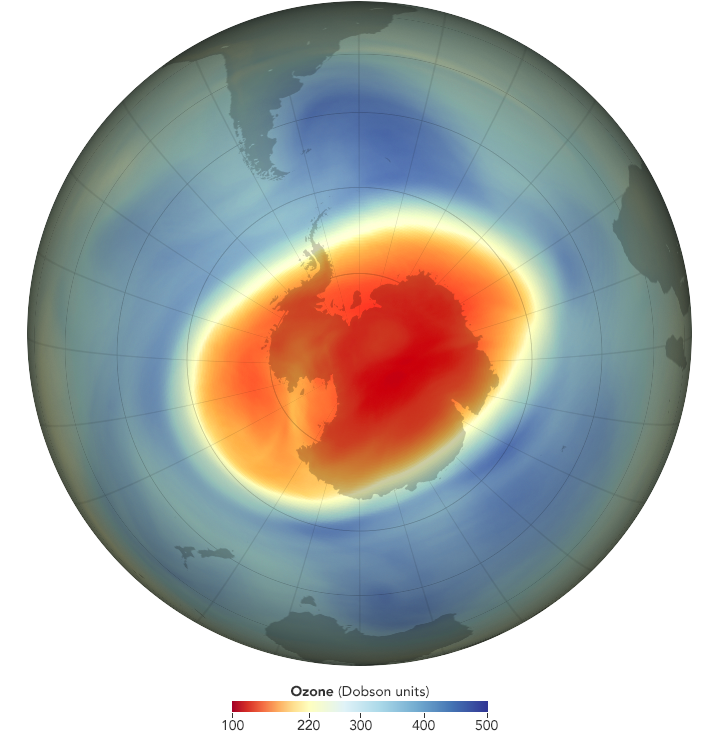
September 20, 2020
Persistent cold temperatures and strong circumpolar winds supported the formation of a large and deep Antarctic ozone hole in 2020, and it is likely to persist into November, NOAA and NASA scientists reported.
On September 20, 2020, the annual ozone hole reached its peak area at 24.8 million square kilometers (9.6 million square miles), roughly three times the size of the continental United States. Scientists also detected the near-complete elimination of ozone for several weeks in a 6-kilometer (4-mile) high column of the stratosphere near the geographic South Pole.
The map above shows the size and shape of the ozone hole over the South Pole on September 20, the day of its maximum as calculated by the NASA Ozone Watch team. NASA and NOAA monitor the ozone hole via complementary instrumental methods. NASA’s Aura satellite, the NASA-NOAA Suomi NPP satellite, and NOAA’s JPSS NOAA-20 satellite all measure ozone from space. Aura’s Microwave Limb Sounder also estimates levels of ozone-destroying chlorine.
This year brought the 12th-largest ozone hole (by area) in 40 years of satellite records, with the 14th-lowest ozone readings in 33 years of balloon-borne instrumental measurements. However, scientists noted that ongoing declines in the atmospheric concentration of ozone-depleting chemicals (which are controlled by the Montreal Protocol) prevented the hole from being as large as it might have been under the same weather conditions 20 years ago.
“From the year 2000 peak, Antarctic stratosphere chlorine and bromine levels have fallen about 16 percent towards the natural level,” said Paul Newman, an ozone layer expert and the chief Earth scientist at NASA’s Goddard Space Flight Center. “We have a long way to go, but that improvement made a big difference this year. The hole would have been about a million square miles larger if there was still as much chlorine in the stratosphere as there was in 2000.”
This year represented a dramatic turnabout from 2019, when warm temperatures in the stratosphere and a weak polar vortex hampered the formation of polar stratospheric clouds (PSCs). The particles in PSCs activate forms of chlorine and bromine compounds that destroy ozone. Last year’s ozone hole was the smallest since the early 1980s, growing to 16.4 million square kilometers (6.3 million square miles) in early September.
“This clear contrast between last year and this year shows how meteorology affects the size of the ozone hole,” said Susan Strahan, a scientist with NASA Goddard and Universities Space Research Association. “It also complicates detection of long-term trends.”
Atmospheric levels of ozone-depleting substances increased up to the year 2000. Since then, they have slowly declined but remain high enough to produce significant seasonal ozone losses. During recent years with normal weather conditions, the ozone hole has typically grown to a maximum of 20 million square kilometers (8 million square miles).
In addition to the area of the ozone hole, scientists also track the average amount of ozone depletion—how little is left inside the hole. On October 1, 2020, weather balloons launched from NOAA’s South Pole atmospheric observatory recorded a low value of 104 Dobson units of atmospheric ozone. NASA’s Ozone Watch reported a lowest daily value at 94 Dobson Units on October 6. Prior to the emergence of the Antarctic ozone hole in the 1970s, the average amount of ozone above the South Pole in September and October ranged from 250 to 350 Dobson units.
The amount of ozone between 13 to 21 kilometers (8 to 13 miles) in altitude, as measured over the South Pole, has been close to record lows at several points this year. “It’s about as close to zero as we can measure,” said Bryan Johnson, a scientist with NOAA’s Global Monitoring Laboratory. Still, the rate at which ozone declined in September was slower compared with 20 years ago, which is consistent with there being less chlorine in the atmosphere.
NASA Earth Observatory image by Joshua Stevens, using data courtesy of NASA Ozone Watch and GEOS-5 data from the Global Modeling and Assimilation Office at NASA GSFC. Story by Theo Stein, NOAA, and Ellen Gray, NASA Earth Science News Team, with EO Staff.
No comments:
Post a Comment